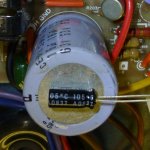Hi there,
I'm trying to fix a Lear Siegler ADM-31 dumb terminal I purchased on Kijiji and I'm hoping to get some guidance on this forum as to how to proceed next. When I initially powered it on, it beeped once before I heard a "pop" and then a little puff of smoke coming out from the back. Upon inspection, I found a burnt tantalum capacitor on the power supply. Replaced it as well as all the electrolytic caps on the power supply and monitor chassis. After that was done, the power supply only made clicking noises.
I found a schematic of the power supply and started to replace components I thought might be causing the problem. Well, after replacing almost every component I finally got the power supply to produce the proper voltages, albeit with a steady high-pitch hum. The problem component turned out to be the opto-coupler.
Confident that I got the power supply working, I connected the mother board to the power supply and turned it on. The monitor displays a vertical green line, makes one continous beep, and the red light on the keyboard is on steady. After about 10 seconds, the vertical line fades away. If I disconnect the monitor from the motherboard, it still makes a continous beep and the red light still stays on steadily. Playing with the pots on the monitor chassis does nothing except for the width coil. If I turn it a certain way with a plastic allen wrench, the monitor will cycle between a vertical line and a horizontal line and beep once every 1/2 second.
It's at this point where I'm stuck as to what to do. Is it a problem with the monitor chassis? Or the motherboard? Or both? How do I diagnose the problem? It's either a short or a bad transistor on the chassis and a bad IC on the mb. I double-checked all the cap's polarity ... all good. The large cap (filter cap?) is a lot smaller than the original so that has me concerned. Did I buy the right one? Same capacitance and voltage rating, just 80% smaller in diameter. I managed to find the manual and schematic for the monitor used in the ADM-31 from the ADM-36 maintenance manual. Apparently the ADM-36 used the same monitor.
My electronic knowledge is average. I know what most components do and can solder. I have an IC tester, IC probe, Multi-meter and an Oscilliscope that I purchased just for this project.
I'm determined to get it working.
I'm trying to fix a Lear Siegler ADM-31 dumb terminal I purchased on Kijiji and I'm hoping to get some guidance on this forum as to how to proceed next. When I initially powered it on, it beeped once before I heard a "pop" and then a little puff of smoke coming out from the back. Upon inspection, I found a burnt tantalum capacitor on the power supply. Replaced it as well as all the electrolytic caps on the power supply and monitor chassis. After that was done, the power supply only made clicking noises.
I found a schematic of the power supply and started to replace components I thought might be causing the problem. Well, after replacing almost every component I finally got the power supply to produce the proper voltages, albeit with a steady high-pitch hum. The problem component turned out to be the opto-coupler.
Confident that I got the power supply working, I connected the mother board to the power supply and turned it on. The monitor displays a vertical green line, makes one continous beep, and the red light on the keyboard is on steady. After about 10 seconds, the vertical line fades away. If I disconnect the monitor from the motherboard, it still makes a continous beep and the red light still stays on steadily. Playing with the pots on the monitor chassis does nothing except for the width coil. If I turn it a certain way with a plastic allen wrench, the monitor will cycle between a vertical line and a horizontal line and beep once every 1/2 second.
It's at this point where I'm stuck as to what to do. Is it a problem with the monitor chassis? Or the motherboard? Or both? How do I diagnose the problem? It's either a short or a bad transistor on the chassis and a bad IC on the mb. I double-checked all the cap's polarity ... all good. The large cap (filter cap?) is a lot smaller than the original so that has me concerned. Did I buy the right one? Same capacitance and voltage rating, just 80% smaller in diameter. I managed to find the manual and schematic for the monitor used in the ADM-31 from the ADM-36 maintenance manual. Apparently the ADM-36 used the same monitor.
My electronic knowledge is average. I know what most components do and can solder. I have an IC tester, IC probe, Multi-meter and an Oscilliscope that I purchased just for this project.
I'm determined to get it working.

